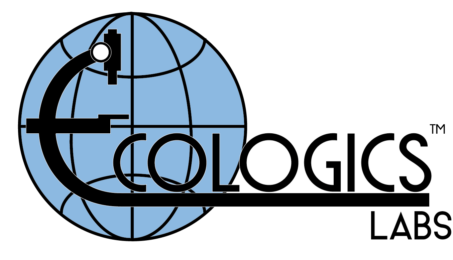Spore Trap Analysis (ASTM D7319-20)
Spore trap/slit impaction cassette sampling is currently the most commonly used, and fastest method for the collection of airborne mold spores. This spore trap method is capable of categorizing and counting mold spores and structures.
A technician sets up an air pump that is attached to a spore trap cassette to run at 15 L/min for 5-10 minutes. The mostly used sampling cassettes are the Zefon Air-O-Cell and AllergencoD. Pumps and cassettes are set in questionable indoor areas and at least one outdoor area, for comparison purposes. Once the samples arrive at the lab, they are prepared using Cotton Blue Stain and a cover slip. Samples are then analyzed using a compound microscope equipped for light microscopy with magnification capability of 40X to 1000X. At least 30% of the slit area is analyzed at 40x and then again at 63x to account for the smaller spores (ex., Aspergillus/Penicillium).
Spores and other particulates are identified to the nearest positive match, using in-house libraries, published reference materials and analyst experience. Keep in mind, the range of counting results that can be determined depends on the size of the spore, the amount of other background particulate matter, the percent that is being analyzed and the volume of air sampled. A high level of background particulate can obscure spores and structures leading to underestimation. A background level of 5 indicates an overloading of background particulate matter and the sample will not be analyzed.
The final results are helpful in deciding whether spore concentration inside a building is “normal” or “abnormal” in comparison to the outdoor air. If your spore counts are higher indoors than outdoors, you can conclude that there is a moisture problem that is facilitating mold growth indoors.
For more information, please visit these links:
- ASTM Method D7391-20
- https://www.epa.gov/mold/brief-guide-mold-moisture-and-your-home
- https://www.osha.gov/mold
- https://www.cdph.ca.gov/Programs/CCDPHP/DEODC/EHLB/IAQ/CDPH%20Document%20Library/MMIMH_112017_ADA.pdf
Tape, Swab and Bulk Analyses (ASTM D7658-21)
Tape sampling is the most common technique used to test surfaces for mold. It provides valuable information such as the species of mold, the relative degree of contamination, and the potential for airborne spore production.
This method can be performed using standard, clear cellophane tape. This involves sampling by direct contact to visible mold. The tape with adhesive side down is gently pressed against a moldy surface to collect the sample. This method is non-invasive and will not damage materials or surfaces, when performed properly.
In the lab, the tape is adhered to a slide with a drop of Cotton Blue Stain. Samples are analyzed at various magnifications under compound light microscopy. The main purpose of the analysis is to visually estimate the presence of any fungal material in the sample. The estimation of fungal and non-fungal material is reported using a scale of categories 1-5 (see below).
| Fungal % |
| 1 = <5% |
| 2 = 5-25% |
| 3 = 25-75% |
| 4 = 75-90% |
| 5 = >90% |
| Non-Fungal |
| 1 = Very Light |
| 2 = Light |
| 3 = Medium |
| 4 = Heavy |
| 5 = Overloaded |
To sample using a swab, simply rub a sterile swab across sampling area – back and forth and side to side, turning the swab with each pass until desired area is sampled and the maximum material has been collected. Return the swab into its sterile container and send it to the lab.
In the lab, the swab is removed from sterile container and gently rubbed on to a piece of clear cellophane tape. Then the analyst continues with the same steps as if a tape sample was received.
To sample a bulk material for mold, deliver a piece of the sample to the laboratory. The lab will then perform a tape lift on that sample and analyze the mold following the same steps as if a tape lift sample were received.
